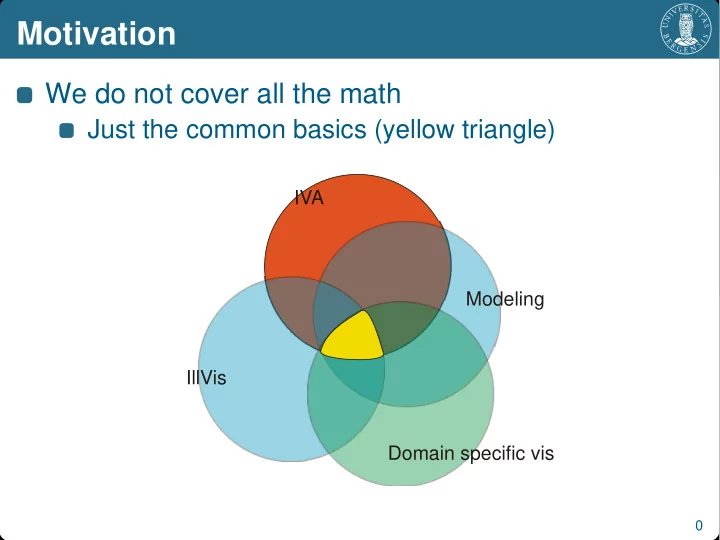

Motivation We do not cover all the math Just the common basics (yellow triangle) IVA Modeling IllVis Domain specific vis 0
Vector spaces and linear systems Julius Parulek
Vector spaces
Vector Spaces Linear combination Vector Space A set for which linear combinations is defined Is closed under those linear combinations Ex: a set of 2D vectors of real numbers a set of 2D vectors of positive real numbers is not! An arbitrary plane and an arbitrary line Their union is not! Their intersection is!
Vector Spaces Linear dependence There exists a linear relationship among vectors Dimension of a linear space The largest number of linearly independent vectors Basis of a linear space A set of n linearly independent vectors for a linear space of dimension n
Vector Spaces Column Space Null space of A Which vectors transform to zero vector?
Vector Spaces Null Space examples Do B -1 , C -1 exist?
Vector Spaces Linear map Defined by a matrix A, v=Au When A has n rows, m columns A defines a map Vector v is in R m , vector u is in R n A is a linear map when Inverse matrix (map) A has to be square! A -1 defines inverse matrix of A A A -1 = I A -1 =A T if A is orthonormal
Vector Spaces Rank of a matrix Number of linear independent vectors (columns) in a matrix A = [a 1 ,a 2 ,…,a n ], rank(A) = dimensions(a 1 ,a 2 ,…,a n ) rank(A)≤min(m,n) Non-full-rank matrices are called singular Full-rank matrices are invertible (have inverse matrix)
Vector Spaces Change of basis v B A
Vector Spaces Example: Transformation to reference frame [Geomcell, parulek et al, 2009] 10
Linear systems
Linear Systems System of equations #equations = #unknows Fit 2 points by a line Exact solution #equations > #unknows Approximate 3 points by a line Approximative solutions #equations < #unknows Fit 3 points by a curve of 4 Free variables Example 12
Linear Systems A linear system of equations for unknowns u 1 ,…,u n Abbreviated to Au=b Au=b is solvable if b is in the column space of A If invertible, then there is only one solution Solution, u = A -1 b u 1 a 1 + u 2 a 2 =b a 1 b a 2
Linear Systems How to solve? Gauss elimination Iterative solvers
Linear Systems Gauss elimination Ex: Transforms matrix into an upper triangular matrix Row exchange can help
Linear Systems Elimination matrix construction Steps encoded into matrices
Linear Systems Elimination matrix construction Steps encoded into matrices C D D*(C*A)=(D*C)*A
Linear Systems Decomposition to lower and upper triangular matrix A=LU If A is symmetric A=LDL T Diagonal matrix of pivots!
Linear Systems Solution stability issues Ill-conditioned (unstable) systems Tiny change of input data results in drastic changes in the solution
Linear Systems Iterative system solver – I. ( Gauss-Jacobi iteration) In case of many thousands of equations, Gauss elimination would be slow Often only few non-zero entries per row in the coefficient matrix (sparse)
Linear Systems Iterative system solver – II. A = D + R, d i,i =a i,i , d i,j =0 if i!=j Iteration step Convergence A is diagonally dominant
Linear systems Use-case for Gauss-Jacobi Fluid Flow 22
Linear systems Data Fitting: Polynomial Interpolation polynomial fit f(t) = sqrt(t) (gray), evaluated at 6 points Approximated by p(t) of degree 4 (black) 23
Linear Systems Overdetermined Systems Au=b, A is not square! Solution A T A = symmetric matrix Pseudinverse matrix (A T A) -1 A T u=(A T A) -1 A T b … or Gauss elimination
Linear systems Solving the null space Columns of A must be linearly depended Otherwise x=[0,…,0] Solving the inverse matrix A[u 1 ,…,u n ]=I 25
Linear Systems Other methods Conjugate Gradients For symmetric and positive definite matrices Iterative and fast method Cramer’s rule Using determinants Impractical for large matrices 26
Linear Systems Use case: manual registration between two images 27
Linear Systems Use case: manual registration between two images Find transformation A (3x3) 28
Literature G. Farin, D. Hansford: Mathematical Principles for Scientific Computing and Visualization http://www.farinhansford.com/books/scv/teaching.html MIT Open Courses, Linear Algebra http://ocw.mit.edu/courses/mathematics/18-06-linear- algebra-spring-2010/video-lectures/ 29
Recommend
More recommend